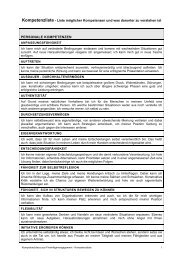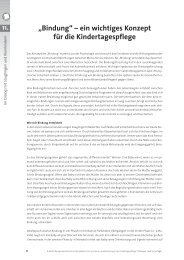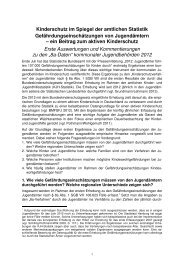download - Deutsches Jugendinstitut e.V.
download - Deutsches Jugendinstitut e.V.
download - Deutsches Jugendinstitut e.V.
You also want an ePaper? Increase the reach of your titles
YUMPU automatically turns print PDFs into web optimized ePapers that Google loves.
ecent population census, a total of 4.7 million inhabitants were resident in these priority<br />
areas; this corresponds to around 8 % of the entire French population.<br />
Action framework for the Urban Renewal Laws passed in 2003<br />
The Urban Renewal Laws which came into effect on 1 August 2003 define action<br />
programmes for the ZUS which are subdivided into six thematic areas and are still included<br />
in current city contracts for the encouragement of social cohesion:<br />
− employment and economic development<br />
− housing and urban environment<br />
− health: prevention and access to medical care<br />
− education: success in education<br />
− public security and order<br />
− mobilisation of public services<br />
The laws specify targets for each of these action fields for a period of five years with<br />
appropriate indicators with which the progress of these measures can be evaluated.<br />
The “National Observation Authority for sensitive urban regions” (ONZUS) was also<br />
created through the same legislation; this authority was assigned the task of measuring the<br />
effects of policies through relevant statutory indicators. The ONZUS is affiliated to the<br />
ministry responsible for urban policy and is obligated to submit an annual report.<br />
Youth issues in the ZUS – a major challenge for urban politics<br />
The history of urban politics in France is characterised by outbreaks of violence on the part<br />
of youths from the “banlieues” [suburbs]: the series of incidents which began in Vaulx-en-<br />
Velin in the suburbs of Lyon in 1981 up to those in November 2005 which took place in<br />
numerous French cities (and not only in problematic districts) reflects the problematic<br />
situation among these young people and highlights their integration difficulties within both<br />
social and employment fields.<br />
The following statistics on the distribution of young persons in the ZUS can be<br />
explained by the strong presence of large families and families from non-European<br />
countries: almost 32 % of the population in the ZUS is younger than 20 years of age<br />
compared with the figure of less than 25 % for the whole of mainland France.<br />
In schools situated within the ZUS, the proportion of pupils from disadvantaged milieus<br />
is particularly high and their living conditions are not conducive to homework. Despite<br />
supplementary funds specifically allocated to institutions in the ZUS for priority education<br />
issues, numerous children and young persons encounter failure in their school career (late<br />
commencement of secondary education and a low success rate in the final exams at the<br />
“collèges“). The proportion of schoolchildren leaving school prematurely before<br />
completing grammar school education or professional training is also high. Young people<br />
from the ZUS display lower levels of ability at the end of basic school education than other<br />
young people. Subsequent integration in employment is therefore also more difficult and<br />
causes a particularly high unemployment rate, delayed admission to permanent and secure<br />
employment and frequent longer-term joblessness. The better qualified amongst this group<br />
are also just as frequently over-qualified for the positions to which they have access.<br />
57

















